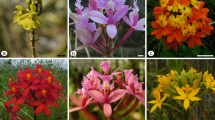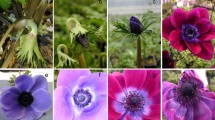Abstract
The longevity of cut Phalaenopsis (Phalaenopsis hybrid, cv. Herbet Hager) flowers is normally 2 to 3 weeks. After pollination however, there was a rapid acceleration of the wilting process, beginning after only 24 h. Enhancement of senescence in several Phalaenopsis cultivars as well as in Doritaenopsis, Dendrobium and Cymbidium, was induced by successful pollination and only slightly or not at all by emasculation. Wilting of the flowers was accompanied by a loss of water from cells of the upper layer of the petals, leading to their upward folding. Following pollination there was an increase in ethylene production and sensitivity to ethylene. The increase in ethylene production began about 10 h after pollination and reached its peak after 30 h. An obvious increase in sensitivity to ethylene could already be detected 4 h after pollination and reached its peak 10 h after pollination. The increase en ethylene sensitivity following pollination was not dependent on endogenous ethylene production as it occurred also in flowers treated with (aminooxy)acetic acid, an inhibitor of ethylene biosynthesis.
Similar content being viewed by others
Abbreviations
- AOA =:
-
(aminooxy)acetic acid
- RH =:
-
relative humidity
- SEM =:
-
scanning electron microscope
References
Arditti J (1979) Aspects of orchids physiology. In: Woolhouse H (ed) Advances in Botanical Research, Vol 7, pp 421–655. Academic Press, London
Arditti J and Flick BF (1976) Post-pollination phenomena in orchid flowers. VI. Excised floral segments of cymbidium. Am J Bot 63: 201–211
Fitting H (1921) Das Verbluhen der Bluten. Naturwissenschaften 9: 1–9
Goh CJ, Halevy AH, Engel R and Kofranek AM (1985) Ethylene evolution and sensitivity in cut orchid flowers. Sci Hortic 26: 57–67
Halevy AH and Mayak S (1979) Senescence and postharvest physiology of cut flowers, Part 1. Hortic Rev 1: 204–236
Halevy AH, Whitehead CS and Kofranek AM (1984) Does pollination induce corolla abscission of cyclamen flowers by promoting ethylene production? Plant Physiol 75: 1090–1093
Halevy AH and Whitehead CS (1989) Pollination-induced corolla abscission and senescence and the role of short-chain fatty acids in the process. In: Osborne DJ and Jackson MB (eds) Cell Separation in Plants, Vol. 35, pp 221–231. NATO ASI Series, Springer Verlag, Berlin
Hoekstra FA and Roekel GCV (1986) Effects of interspecific pollination on stylar ethylene production and flower longevity in Petunia hybrida. Acta Hortic 181: 105–212
Hoekstra FA and Weges R (1986) Lack of control by early pistillate ethylene of the accelerated wilting of Petunia hybrida flowers. Plant Physiol 80: 403–408
Nadeau JA, Zhang XS, Nair H and O'Neill SD (1993) Temporal and spatial regulation of 1-aminocyclopropane-1-carboxylate oxidase in the pollination-induced senescence of orchid flowers. Plant Physiol 103: 31–39
Nichols R, Bufler J, Mor Y, Fujino DW and Reid MS (1983) Changes in ethylene production and 1-aminocyclopropane-1-carboxylic acid content of pollinated carnation flowers. Plant Growth Regul 2: 1–8
O'Neill SD, Nadeau JA, Zhang XS, Bui AQ and Halevy AH (1993) Interorgan regulation of ethylene biosynthetic genes by pollination. The Plant Cell 5: 419–432
Porat R, Reuveni Y, Borochov A and Halevy AH (1993) Petunia flower longevity: the role of sensitivity to ethylene. Physiol Plant 89: 291–294
Stead AD (1992) Pollination-induced flower senescence: a review. Plant Growth Regul 11: 13–20
Strauss MS and Arditti J (1984) Postpollination phenomena in orchid flowers. XII. Effects of pollination, emasculation, and auxin treatment on flowers of Cattleya porica ‘Cinnizaro’ and the rostellum of phalaenopsis. Bot Gaz 145: 60–72
Trewavas A (1982) Growth substance sensitivity: the limiting factor in plant development. Physiol Plant 55: 60–72
Whitehead CS, Halevy AH and Reid MS (1984) Roles of ethylene and 1-aminocyclopropane-1-carboxylic acid in pollination and wound-induced senescence of Petunia hybrida flowers. Physiol Plant 61: 643–648
Whitehead CS and Halevy AH (1989) Ethylene sensitivity: the role of short-chain saturated fatty acids in pollinated Petunia hybrida flowers. Plant Growth Regul 8: 41–54
Woltering EJ and Harren F (1989) Role of rostellum in emasculation-induced phenomena in orchid flowers. J Exp Bot 40: 907–912
Yang SF and Hoffman NE (1984) Ethylene biosynthesis and its regulation in higher plants. Annu Rev Plant Physiol 35: 155–189
Zacarias L and Reid MS (1991) Variation in the senescence of carnation (Dianthus caryophyllus L.) cultivars. II. Comparison of sensitivity to exogenous ethylene and to ethylene binding. Sci Hortic 48: 109–116
Zhang XS and O'Neill SD (1993) Ovary and gametophyte are coordinately regulated by auxin and ethylene following pollination. The Plant Cell 5: 403–418
Author information
Authors and Affiliations
Rights and permissions
About this article
Cite this article
Porat, R., Borochov, A., Halevy, A.H. et al. Pollination-induced senescence of Phalaenopsis petals. Plant Growth Regul 15, 129–136 (1994). https://doi.org/10.1007/BF00024102
Received:
Accepted:
Issue Date:
DOI: https://doi.org/10.1007/BF00024102




